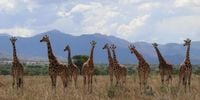For centuries, giraffes have been a symbol of Africa’s wild majesty, their long necks and patchwork coats gracing grasslands from the Sahel to the southern savannas. But on August 21, 2025, the International Union for Conservation of Nature (IUCN) officially upended scientific convention: the world’s tallest land mammal is not one species, but four, each with its own evolutionary story and conservation crisis.
This landmark decision, announced by the IUCN Species Survival Commission’s Giraffe and Okapi Specialist Group (GOSG), marks the culmination of more than a decade of research. According to the Giraffe Conservation Foundation (GCF), the genetic differences between the newly recognized species—Masai, northern, reticulated, and southern giraffes—are as significant as those that separate brown bears from polar bears. It’s a revelation that could reshape conservation efforts across Africa and beyond.
“This recognition is more than academic,” Dr. Julian Fennessy, GCF’s Director of Conservation, told IFLScience. “Each giraffe species faces different threats, and now we can tailor conservation strategies to meet their specific needs. It gives African countries and the global community the tools to act—before it’s too late.”
Historically, giraffes were lumped together as a single species with nine subspecies, a view that had gone unchallenged since 1758. But as genetic technology advanced, researchers began to suspect that the story was more complicated. The GOSG’s Taxonomic Task Force, launched in 2024, set out to review the latest genetic, morphological, and biogeographical data. Their findings? Giraffes are among the most genetically well-studied large mammals in Africa, and the distinctions between lineages are stark.
Analyses of nuclear and mitochondrial DNA, drawn from thousands of samples collected across 21 African countries, consistently revealed deep genetic divisions. “To describe four new large mammal species after more than 250 years of taxonomy is extraordinary,” said Professor Axel Janke of the Senckenberg Biodiversity and Climate Research Centre, which co-led the research. “Especially for animals as iconic as giraffes, which roam Africa in plain sight.”
But it wasn’t just genes that set the species apart. Morphological studies—comparing skull structures and bone shapes—showed notable differences across regions. What appear like horns on a giraffe’s head, for example, are actually permanent bony protrusions, distinct from the antlers of deer. Biogeographical assessments also played a role, considering natural barriers like rivers, rift valleys, and arid zones that could have isolated populations over millennia.
The result: four distinct species, each with their own subspecies. The northern giraffe (Giraffa camelopardalis) includes the West African, Kordofan, and Nubian giraffes. The reticulated giraffe (Giraffa reticulata) is mostly found in northern Kenya. The Masai giraffe (Giraffa tippelskirchi) roams the savannas of Tanzania and Kenya, while the southern giraffe (Giraffa giraffa) is divided into South African and Angolan subspecies.
This taxonomic shake-up isn’t just a matter of scientific tidiness. It has urgent, real-world consequences. According to the GCF’s 2025 status report, giraffes have vanished from nearly 90% of their former prime habitats, including extinction in several West African countries. The northern giraffe is now the most endangered, with fewer than 6,000 individuals left in the wild and facing severe threats from poaching and political instability in regions like the Democratic Republic of Congo, South Sudan, and the Central African Republic. “It’s one of the most threatened large mammals in the world,” said Stephanie Fennessy, GCF’s Executive Director, as quoted by ABC News.
Reticulated giraffes, once numbering 36,000, have plummeted to around 16,000—a more than 50% decline in 35 years. Masai giraffes, common in Tanzania’s national parks, have a population of about 45,400, while southern giraffes are relatively stable at approximately 49,850 individuals, according to GCF. Other estimates, cited by AP News, suggest the southern giraffe population is closer to 69,000, but all agree that their numbers are healthiest among the four.
“When you lump giraffes all together, it muddies the narrative,” explained Michael Brown, Co-Chair of the GOSG and Conservation Science Coordinator for the GCF, to AP News. “Each species has different population sizes, threats, and conservation needs.” For example, while northern giraffes are beset by poaching and unrest, Masai giraffes are losing habitat as open savannas are converted into cattle pastures and fields. Reticulated giraffes face their own unique pressures in the arid north of Kenya.
The practical upshot of the new classification is that each species will now be independently assessed for the IUCN Red List of Threatened Species™, opening the door to targeted protections under international agreements like the U.S. Endangered Species Act. Conservation funding can be directed more precisely, and strategies such as habitat protection, anti-poaching patrols, and community-based conservation can be tailored to the needs of each species.
“Recognising these four species is vital not only for accurate IUCN Red List assessments, targeted conservation action and coordinated management across national borders. The more precisely we understand giraffe taxonomy, the better equipped we are to assess their status and implement effective conservation strategies,” Brown told IFLScience.
This recognition also comes at a pivotal moment, just weeks before the IUCN World Conservation Congress, set for October 9-15, 2025, in Abu Dhabi. The Congress, one of the world’s largest forums for nature conservation, will bring together decision-makers from government, civil society, Indigenous organizations, academia, and business to set the conservation agenda for decades to come. The fate of Africa’s four giraffe species—and the strategies needed to halt their decline—will be high on the agenda.
Advances in genetic sequencing technology have made this kind of research more accessible than ever. Over the past 20 years, the cost of sequencing a giraffe genome has dropped from tens of thousands of dollars to about $100, according to GCF. This has allowed nonprofit and conservation groups to amass a vast trove of data, making giraffes one of the most genetically studied large mammals in Africa.
For many conservationists, the new classification is both a wake-up call and a cause for hope. “What a tragedy it would be to lose a species we only just learned existed,” Stephanie Fennessy reflected. The next step, as outlined by the GCF, is to implement species-specific strategies that address the unique threats facing each giraffe, from habitat fragmentation to poaching and climate change.
As the dust settles on this historic reclassification, one thing is clear: the future of Africa’s giraffes depends on seeing them not as a single, iconic species, but as four distinct branches of the evolutionary tree—each deserving of its own place in the sun.






